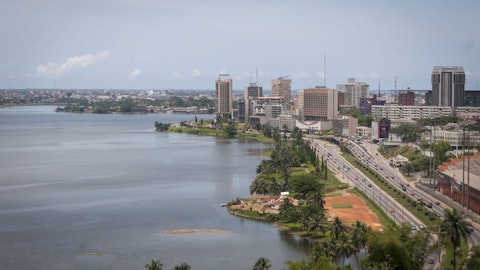In this article, we will look at the 12 most populated countries in South America. If you wish to skip our detailed analysis, you can go directly to the 5 Most Populated Countries in South America.
South America is the southern portion of the Americas. It ranks among the most peaceful continents in the world, as it has experienced no armed conflict since the dawn of the 21st century. The continent touches the Pacific Ocean in the west, the Atlantic Ocean in the east and north, and the Caribbean Sea to the northwest.
Population Trends in South America
According to estimations made by the United Nations Department of Economic and Social Affairs Population Division, South America had a population of more than 434 million in 2021. This number is lower than the population of certain individual countries, namely India and China, which have a higher population than the entire South American region. The region has an area of 17,840,000 sq. kilometers, which is 6,890,000 sq. miles. That makes it the fourth largest continent in the world in terms of area, right after Asia, Africa, and North America. When viewed in terms of population, South America is the fifth most populated continent in the world after Asia, Africa, Europe, and North America. The latest statistics by the United Nations Population Division reveal that South America’s population comes up to 5.47% of the total world population.
According to data by the World Bank, Latin America and the Caribbean had a 0.7% annual growth rate in 2022. This rate has been decreasing since 2014, going from 1.1% in 2014 to 1% in 2015 and 0.9% in 2018. South America has only 12 sovereign countries, notably less as compared to other continents. Brazil alone takes over more than half of the region’s area, which also makes it the most populated country in the region. According to a study by Luis L Schenoni, Brazil’s control over South America’s material power has increased from one-third to one-half since the end of the 20th century. Despite that, around 44,000 Brazilians were internally displaced in 2022 because of disasters. This number was the highest in the region, standing next to Colombia’s 41,000 internally displaced individuals by the end of 2022.
Another report by the Population Reference Bureau showed that 68% of South America’s population stood between the 15-64 age group, with 22% of the population below the 15-year limit. People aged 65 or older made 10% of the population in mid-2023. The highest fertility rate in the region was reported in Bolivia, with 2.5 lifetime births per woman. On the other hand, South American countries with the lowest fertility rates were Chile and Uruguay, with 1.2 and 1.5 lifetime births per woman, respectively.
Economic Outlook of South American Countries
According to a report by the World Bank, Latin America and the Caribbean have demonstrated extraordinary economic resilience over the past 30 years. The region has mitigated unprecedented hindrances like global uncertainty, rising debt, increasing inflation, and reduced commodity prices. Such efforts have bolstered its return to pre-pandemic employment levels.
The report predicts that the region’s Gross Domestic Product (GDP) will increase by 2.3% in 2024 and 2.6% in 2025. Regional growth in the region was 0.7% higher in 2023, primarily because of the boosted economic outputs of the two major economies in Latin America and the Caribbean: Brazil and Mexico. Brazil underwent this increase because of better than expected outcomes in private consumption, agricultural production, and exports in the first three quarters of 2023. In contrast, Mexico saw an improvement in investment growth and private consumption, leading to its better-than-expected output.
Key Players in the South American Economy
South America boasts some exceptional companies driving its economy, of which MercadoLibre, Inc. (NASDAQ:MELI), Vale S.A. (NYSE:VALE), and Petróleo Brasileiro S.A. – Petrobras (NYSE:PBR) are a few. Let’s take a look at these companies.
MercadoLibre, Inc. (NASDAQ:MELI), famously called the “eBay of Latin America,” is an e-commerce platform operational since 1999. This online marketplace connects sellers with buyers, allowing people to undertake seamless online transactions. Based in Argentina, it operates in several countries including Chile, Brazil, and also Mexico in North America. MercadoLibre, Inc. (NASDAQ:MELI) also ranked on the “Americas’ Fastest Growing Companies in 2023” list by Financial Times. On March 15, Bloomberg reported that the company increased its investment in Mexico to $2.5 billion in 2024, up from $1.6 billion in 2023. The additional investment will go into warehouse expansion, technology and marketing investment, loan payments, and improvement of the logistics network.
Another prominent company in the South American economy is Vale S.A. (NYSE:VALE), a multinational mining company centered in Brazil. Vale S.A. (NYSE:VALE) is widely regarded as the largest company in Latin America, and has been around for more than seven decades. Since its inception as a primarily iron ore extraction company, Vale S.A. (NYSE:VALE) has expanded its functioning to the production and export of copper, iron ore, nickel, coal, and other minerals. As the lead regulator of Latin America’s mining industry, the company has announced its goal to use 100% renewable energy for all its operations by 2030. The company owns the Sol do Cerrado solar panel project, which supplies 16% of the total energy consumed by the company in Brazil while working at its maximum capacity of 766MW. Ludmila Nascimento, Vale’s energy and decarbonisation director, said that the project is contributing to their “goal of being leaders in sustainable mining.”
Petróleo Brasileiro S.A. – Petrobras (NYSE:PBR) is another South American company at the forefront of innovation. The company began its operations in 1953 as an oil and gas company owned by the Brazilian state. It has since then developed into a multi-faceted organization involved in the production, refining, distribution, and extensive exploration of petroleum-related products. Petróleo Brasileiro S.A. – Petrobras (NYSE:PBR) has placed Brazil in the lead in the global oil and gas industry. On March 7, Petróleo Brasileiro S.A. – Petrobras (NYSE:PBR) released its Q4 2023 earnings. The company reported a revenue of $25.27 billion and outperformed estimates by $15.53 million. The company reported an EPS of $0.85 and outperformed EPS expectations by $0.02. Here is what the company’s Financial Director, Sergio Caetano, had to say during the company’s Q4 2023 earnings call:
“We added value to the company in the amount of BRL150 billion and compensation to shareholders 20.4 billion with 19.7 billion in dividends and $0.7 billion in the repurchase of shares. To society, we paid between taxes and governmental shares, BRL240 billion, BRL36.6 billion of all dividends paid by Petrobras went to the controlling group that’s comprised by the federal government.
We also contributed another BRL54 billion in the valuation of the public assets of the state. So, in addition to adding value, that was also an important collaboration with society in terms of reverting these resources to taxes and dividends. These are some more data in terms of our financial earnings. An EBITDA of 52.4 billion is the second biggest in history. The operational cash flow, 43.2 billion, the second biggest in history. A free cash flow, $31.1 billion, the third biggest in history. A net revenue, a net profit of 24.9 billion, the second biggest in history. And these numbers, the second highest and third highest, they were produced in a very adverse external environment. So we achieved second and third place with a special highlight.
Another important aspect when it comes to our financial debt of 28.8 billion, with a reduction of $1.2 billion this year. Return on capital employed 11.2%, which is in line with the previous results. We also brought about the lowest difference vis-à-vis, the American bond to the market. And with that, we won an award, the Quasi-Sovereign Bond Deal of the Year award by issuing $1.5 billion in 10-year bonds”.
With this context, let’s look at the 12 most populated countries in South America.

Pixabay/Public Domain
Our Methodology
To compile a list of the 12 Most Populated Countries in South America, we have taken population as the primary and sole metric. We utilized data from the most recent population index put forth by the World Bank. The additional data for countries has been taken from the World Bank’s country profiles. The most recent data available is from 2022. The list of the 12 Most Populated Countries in South America is arranged in ascending order of their population estimates, as of 2022.
12 Most Populated Countries in South America
12. Suriname
Population as of 2022: 618,040 people
Suriname has a population of 618,040 people, ranking 12th on our list of the 12 most populated countries in South America. According to estimates by the World Bank, the country has a 0.8% annual population growth with a -1000 net migration as of 2022. Suriname is located on the northeastern coast of South America, and borders Guyana, Brazil, and French Guinea.
11. Guyana
Population as of 2022: 808,726 people
Located on the North Atlantic coast in South America, Guyana had a total population of 808,726 people with a 0.5% annual population growth in 2022. According to estimates by the World Bank, the country has a net migration of -3,900 as of 2022, with a 63.4% annual GDP growth.
10. Uruguay
Population as of 2022: 3,422,794 people
The Oriental Republic of Uruguay is located on the southeastern South American coast and is the second smallest country on the continent. The country’s population has undergone a decrease since 2020, going from 3.429 million in 2020 to 3.426 million people in 2021. According to the World Bank, the country’s net migration is -1500, which means that around 1500 people migrated to countries abroad in 2023. The country’s population growth rate is also declining as it was -0.1% in 2022. It ranks tenth on our list of the 12 most populated countries in South America with a population of 3.422 million as of 2022.
9. Paraguay
Population as of 2022: 6,780,744 people
With a population of 6.7 million, Paraguay is another landlocked country that ranks ninth on our list of the 12 most populated countries in South America. According to data from the World Bank, the country’s population has grown steadily, going from 5.923 million people in 2012 to 6.703 million people in 2021. It is located between Argentina, Bolivia, and Brazil in south-central South America.
8. Bolivia
Population as of 2022: 12,224,110 people
Officially known as the Plurinational State of Bolivia, the country has a population of around 12.2 million people and is eighth on our list. This landlocked country is located in the western portion of central South America. Bolivia borders Peru and Chile to its west, Brazil to its east and north, and Argentina and Paraguay to its south.
7. Ecuador
Population as of 2022: 18,001,000 people
Ecuador lies on South America’s western coast, and is famous for the equator line that passes through it. With a population of around 18 million people, it ranks seventh on our list of the 12 most populated countries in South America. Ecuador boasts a portion of the Amazon rainforest and the Galápagos Islands, which are rich in diverse wildlife.
6. Chile
Population as of 2022: 19,603,733 people
The Republic of Chile ranks among the countries with the most unique geographical dimensions. It sits as a long, narrow stretch of land along the western edge of South America, bordering Argentina, Peru, and Bolivia. The country also shares a 6,000-kilometer-long coastline with the Pacific Ocean. With a population of around 19.60 million people as of 2022, Chile ranks sixth on our list.
Click to continue reading and see the 5 Most Populated Countries in South America.
Suggested Articles:
- 16 Safe and Affordable Cities in South America for Expats
- 10 Most Innovative Economies in Central and South America
- 15 Cheapest Countries To Live in Central and South America
Disclosure: None. 5 Most Populated Countries in South America is originally published on Insider Monkey.





